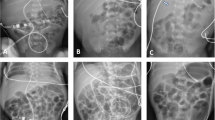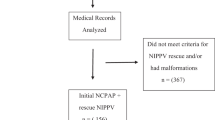Abstract
Objective:
To determine whether early radiologic evidence of severe respiratory distress syndrome (RDS) is predictive of nasal continuous positive airway pressure (CPAP) failure in extremely low birth weight (ELBW) infants during the first 72 h of age.
Study design:
Retrospective analysis of 235 consecutively inborn ELBW infants who received initial support with CPAP. CPAP success (n=151) and CPAP failure (n=84) groups were designated according to outcome within the first 72 h of age. We assessed the ability of radiologic evidence of severe RDS in the initial chest radiograph, alone and in combination with other variables available in the first hours of life, to predict CPAP failure.
Result:
Severe RDS had a positive predictive value (PPV) of 0.81 (95% confidence interval (CI) 0.64, 0.92) for CPAP failure. The combination of severe RDS and gestational age (GA)⩽26 weeks had a PPV of 0.92 (95% CI 0.68, 0.96).
Conclusion:
Early radiologic evidence of severe RDS is predictive of CPAP failure, especially in infants with GA⩽26 weeks.
This is a preview of subscription content, access via your institution
Access options
Subscribe to this journal
Receive 12 print issues and online access
$259.00 per year
only $21.58 per issue
Buy this article
- Purchase on Springer Link
- Instant access to full article PDF
Prices may be subject to local taxes which are calculated during checkout

Similar content being viewed by others
References
Finer NN, Carlo WA, Walsh MC, Rich W, Gantz MG, Laptook AR et al. Early CPAP versus surfactant in extremely preterm infants. New Engl J Med 2010; 362: 1970–1979.
Dunn MS, Kaempf J, de Klerk A, de Klerk R, Reilly M, Howard D et al. Randomized trial comparing 3 approaches to the initial respiratory management of preterm neonates. Pediatrics 2011; 128: e1069–e1076.
Sandri F, Plavka R, Ancora G, Simeoni U, Stranak Z, Martinelli S et al. Prophylactic or early selective surfactant combined with nCPAP in very preterm infants. Pediatrics 2010; 125: e1402–e1409.
Tapia JL, Urzua S, Bancalari A, Meritano J, Torres G, Fabres J et al. Randomized trial of early bubble continuous positive airway pressure for very low birth weight infants. J Pediatr 2012; 161: 75–80.
Hillman NH, Kallapur SG, Pillow JJ, Moss TJ, Polglase GR, Nitsos I et al. Airway injury from initiating ventilation in preterm sheep. Pediatr Res 2010; 67: 60–65.
Carlo WA . Gentle ventilation: the new evidence from the SUPPORT, COIN, VON, CURPAP, Colombian Network, and Neocosur Network trials. Early Hum Dev 2012; 88: 70022–70021.
American Academy of Pediatrics: Committee On Fetus and Newborn. Respiratory support in preterm infants at birth. Pediatrics 2014; 133: 171–174.
Polin RA, Carlo WA . Committee On Fetus and Newborn. Surfactant replacement therapy for preterm and term neonates with respiratory distress. Pediatrics 2014; 133: 156–163.
Rojas-Reyes MX, Morley CJ, Soll R . Prophylactic versus selective use of surfactant in preventing morbidity and mortality in preterm infants. Cochrane Database Syst Rev 2012; 14: 3.
Whitsett JA, Wert SE, Weaver TE . Alveolar surfactant homeostasis and the pathogenesis of pulmonary disease. Annu Rev Med 2010; 61: 105–119.
Ammari A, Suri M, Milisavljevic V, Sahni R, Bateman D, Sanocka U et al. Variables associated with the early failure of nasal CPAP in very low birth weight infants. J Pediatr 2005; 147: 341–347.
Kero PO, Mäkinen EO . Comparison between clinical and radiological classifications of infants with the respiratory distress syndrome (RDS). Eur J Pediatr 1979; 130: 271–278.
Vermont Oxford Network. Nightingale data definitions. Vermont Oxford Network, Burlington, Vermont, 2010.
Vermont Oxford Network. Respiratory outcomes VLBW Infants, 2010. Vermont Oxford Network, editor. Burlington, Vermont, 2011.
De Jaegere AP, van der Lee JH, Canté C, van Kaam AH . Early prediction of nasal continuous positive airway pressure failure in preterm infants less than 30 weeks gestation. Acta Paediatrica 2012; 101: 374–379.
Rocha G, Flor-de-Lima F, Proenca E, Carvalho C, Quintas C, Martins T et al. Failure of early nasal continuous positive airway pressure in preterm infants of 26 to 30 weeks gestation. J Perinatol 2013; 33: 297–301.
Dargaville PA, Aiyappan A, De Paoli AG, Dalton RGB, Kuschel CA, Kamlin CO et al. Continuous positive airway pressure failure in preterm infants: Incidence, predictors and consequences. Neonatology 2013; 104: 8–14.
Fuchs H, Lindner W, Leiprecht A, Mendler MR, Hummler HD . Predictors of early nasal CPAP failure and effects of various intubation criteria on the rate of mechanical ventilation in preterm infants of <29 weeks gestational age. Arch Dis Child Fetal Neonatal Ed 2011; 96: F343–F347.
Author information
Authors and Affiliations
Corresponding author
Ethics declarations
Competing interests
No external funding was used to support the conduct of the study or manuscript preparation. The first draft was written by Thea Tagliaferro, MD. The authors declare no conflict of interest.
Rights and permissions
About this article
Cite this article
Tagliaferro, T., Bateman, D., Ruzal-Shapiro, C. et al. Early radiologic evidence of severe respiratory distress syndrome as a predictor of nasal continuous positive airway pressure failure in extremely low birth weight newborns. J Perinatol 35, 99–103 (2015). https://doi.org/10.1038/jp.2014.164
Received:
Revised:
Accepted:
Published:
Issue Date:
DOI: https://doi.org/10.1038/jp.2014.164
This article is cited by
-
Predicting the need for intubation within 3 h in the neonatal intensive care unit using a multimodal deep neural network
Scientific Reports (2023)
-
Current Controversies and Advances in Non-invasive Respiratory Support for Preterm Infants
Current Treatment Options in Pediatrics (2022)
-
Prospective observational study of early respiratory management in preterm neonates less than 35 weeks of gestation
BMC Pediatrics (2019)
-
Early predictors of continuous positive airway pressure failure in preterm neonates
Journal of Perinatology (2019)



